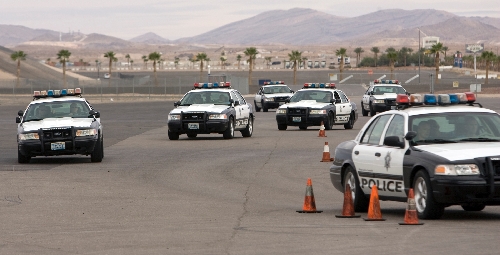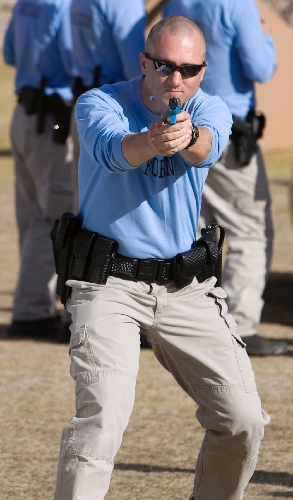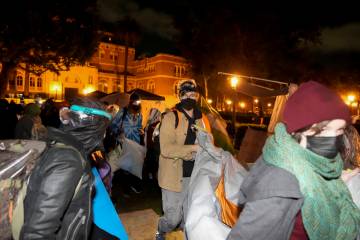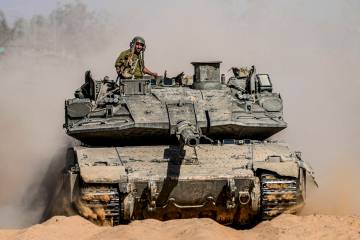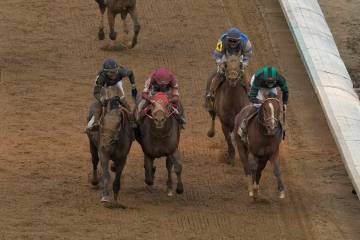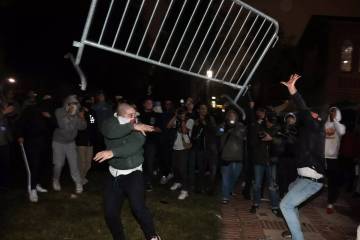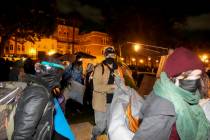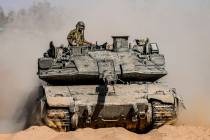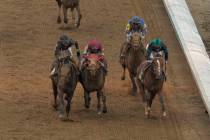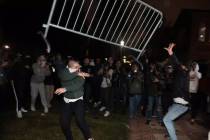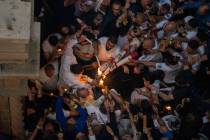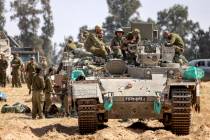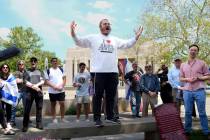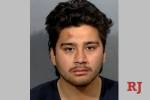Police training culminates with advanced techniques
The strobe light flashes. The rock music blares.
One by one, the police academy recruits walk into what they think is a bar fight, unaware of what's behind the door.
From the darkness, a knife-wielding attacker lunges at them. A few draw their guns and fire. They live.
Most freeze, pull their Tasers or do any number of things besides pull their guns. For the purposes of the exercise, they die.
Then two men circle and attack with shield-like pads, pounding the recruits as they try to fend them off with batons. Most spend more time on their backs than on their feet.
Then the men with pads smother the recruits with all their weight, only getting up so another man in fighting gloves can mount them and punch away.
By then most of the recruits, exhausted and worn out, have no chance. They lie on the ground, cover up and take the punches to their heads, backs and ribs.
"You're just going to lay there and die? You know you're better than that," officer Bill Brewer screams at Eugene Yanga, the first recruit to take the pummeling.
After watching the first few recruits give up the fight, Brewer storms out.
"That was a mess," he says. "That was disgusting."
When the exercise ends, the staff is furious. Brewer calls it one of the worst performances by a class he's ever seen. Some of them were defeated the moment they walked into the room, he says.
"What we're measuring is your heart," he said. "Some of you gave up."
On the streets, that lack of heart will get them killed, says Dean Leslie, the officer in charge of Class 6-09.
"Some of you in here don't have any fire in your gut," he says. "If you can't do it in practicals, you can't do it in real life, and you're going to be dead."
They'll need to rethink whether they have what it takes to be a cop.
That was the drill Sgt. Dan Zehnder had warned the class about weeks ago in the middle of all those push-ups and sit-ups and laps around the track at the Metropolitan Police Department Academy.
For three months, the academy staff has tried to build the sense of fight in the recruits, instilling in them the idea that out on the streets, giving up gets you killed.
The drill comes after the class moves its daily training from the Jerry Keller Training Center on West Cheyenne Road to the Mojave Training Center off Bonanza Road.
The move halfway through the six-month academy marks a transition in the recruits' training. They'll build upon the basic material they learned in the first half of the academy and develop the more advanced tactics and skills they'll need as beat cops.
By now five of the original recruits have quit, but five others have replaced them under the academy's recycle program. They were members of other classes who struggled in one area or another. Some of them made it to the last week of the academy before failing the final test.
In the past they would have been dropped from the academy and forced to restart the application and testing process if they still wanted to rejoin the force.
Under the recycle program, recruits who are struggling academically, get hurt or are falling behind can get a second chance. A committee of academy staffers judges the recruits on a case-by-case basis, reviewing their academic performances and disciplinary records.
If they're approved for a recycle, the recruits will be dropped into another class at a spot in the curriculum deemed appropriate.
Besides giving a second chance, the recycle program also helps the Police Department salvage time and money already invested in the recruits instead of having to screen, hire and train their replacements. During the program's three years, 63 recruits were recycled. Of those, 43 finished the academy.
(Since Class 6-09 graduated, however, the recycle program has been stopped.
A key to the program was the monthly academies that allowed struggling recruits to be dropped immediately into another class at the appropriate spot in the curriculum.
But the monthly academies ended after the department finished hiring roughly 600 new officers under the More Cops sales tax, and the scattered academy classes that followed made it impractical to continue the recycle program.}
Shortly after moving to Mojave, Class 6-09 will lose two more recruits to injury. They'll be recycled to another class, cutting the number of original recruits left in the class to 19.
The recruits who left in recent weeks gave a variety of reasons. Maybe it was a new job or business opportunity. Maybe it was an injury they couldn't overcome. Maybe it was child care issues.
Recruits on the way out rarely admit the real reasons for quitting, such as being unable to handle the academics or not having what it takes to be a police officer, Zehnder says.
Academy staffers can often predict who will quit, but not in the case of Jacob Kelecava.
The former Air Force military police officer was performing well at the academy, and staffers expected him to make it.
But country and desert, like oil and water, don't mix.
Kelecava grew up in northeast Ohio, hunting and fishing in the woods surrounding his hometown.
Two weeks before the academy, he moved to Las Vegas from Florida, where he was stationed, with his fiancee, who grew up here. The country boy tried to fit in, but it was too much -- the urban sprawl, the desert landscape, the too-small driveway that couldn't fit his truck.
"It just wasn't my cup of tea at all," he said.
Shortly before the halfway point, he resigned, broke up with his fiancee and moved back home. He returned to the Air Force as a military police officer on a base in Youngstown, Ohio.
"I'm doing a job I love," he said, adding that he's using some of the techniques and tactics learned at the academy in his new job.
His advice to out-of-state police recruits -- spend at least a month in Las Vegas before committing.
"If that academy was in Ohio, I'd be grinning from one ear to the next," he said.
The engine roars and the tires squeal, but Lt. Tim Leveque is as calm as can be.
"Gas. Gas. Gas. Gas. Gas."
"Off the brake. Now come in and stay high."
"Don't jerk it. Get off the brake."
Recruit Kamran Aliyev is behind the wheel, jerking the patrol car around the winding track like he's back in the Army driving a tank. From the passenger seat Leveque guides him around the turns and up the straightaways, showing him to feel the car instead of fighting it.
"Look through your turn. Now peel it down through the turn."
"Peel it down. Peel it down."
"Give it gas. Gas."
The recruits of Class 6-09 have arrived at one of the best parts of their six-month journey, the Emergency Vehicle Operations Center, or EVOC.
In four days at the Las Vegas Motor Speedway, they'll learn to drive a car like they've never driven one before. They'll learn about the physics and mechanics of driving, how cars react, and how to use the combination of steering, acceleration and braking to make the car do what they want without losing control.
They'll learn how to pursue a vehicle and how to spin it to a stop with the Precision Intervention Technique, or PIT.
Above all, they'll learn how to get to a call as fast as possible without compromising safety. It's a lesson that carries more weight now.
A week earlier, officer Milburn "Millie" Beitel was killed and another officer was critically injured when their patrol car crashed and flipped. Neither officer was wearing a seat belt in the car, which was speeding 71 mph in a 45 mph zone.
That crash came exactly five months after officer James Manor died when his patrol car slammed into a pickup turning left in front of him. Manor's car was moving more than 100 mph in a 45 mph, and he wasn't wearing a seat belt.
Leveque and his staff remind the recruits that they can't help anyone if they don't get to the scene in one piece. The deaths of Beitel and Manor make that clearer than ever.
"We owe it to them to learn from them so it doesn't happen to the next guy," Leveque says.
Sheriff Doug Gillespie spoke to the class during a visit that had been scheduled before Beitel's death. He told the recruits how driving is the most dangerous thing police do, and he reminded them that the academy instructors will teach them the right way to do it, even though many officers cut corners out on the street.
"This is one of those areas you don't cut corners," Gillespie said.
When the sheriff learned to drive in the academy three decades ago, the training was "go as fast as you could go," he said.
Recruits used to wear helmets and racing harnesses, reinforcing a speed-first mentality. That evolved through the years into the more realistic set-up in the current training regimen, which puts the recruits in regular patrol cars wearing only seat belts.
On the course, Leveque and his staff emphasize vision behind the wheel -- seeing the road as a series of points and arcs to guide the recruits around the track. When the recruits hit those points smoothly, the cars move around the twists and turns of the track like ballet dancers. When they don't, the cars thump back and forth like heavy metal rockers.
In the car with Aliyev and Bashir Assamily, Leveque reminds them that smooth comes before speed.
"Speed is not going to help us get around here faster," he says. "Smooth."
Take it slow. Focus on vision. Be patient. The speed will come.
Early on, Aliyev drives more heavy metal than ballet. He's connecting the dots on the road instead of flowing from one to the next.
"You're getting tunnel vision," Leveque tells him. "You're seeing the turn and you're going right at it."
After several times around the track, Aliyev gets a little smoother. He goes a little faster -- too fast for the hairpin turn.
He loses control, and the patrol car spins into the dirt, kicking up a cloud of dust.
"Way too much speed, Turbo," Leveque says.
Everyone in the car is OK, but lesson learned.
This was only a practice run. The real test comes on the last day of the week.
The flat, wide-open track looks nothing like a city street, but the instructors create their best imitation, using stop signs, cars at intersections and other distractions to create as realistic an environment as possible.
Each recruit gets three chances to pass the simulated pursuit. Crossing the centerline means automatic failure of that run.
"We haven't had to fail anyone before, but we will," Leveque says.
Nathan Herlean climbs into the car and cracks a joke, as usual.
"You're allowed to kick me out whenever you want," he tells his grader, officer Eric Holyoak. "Just open the door and hit the button and kick me out."
Herlean says he's always nervous about tests, but there's no time to be nervous now.
The white Camaro in front of him takes off. He flips on the lights and sirens and hits the gas.
Herlean tries to keep up but waits too long to move through an intersection. He falls too far behind and fails.
Holyoak reassures him.
"I expect you to lose more pursuits (in real life) than you're going to get because there's a lot more traffic," he says.
On try No. 2 Herlean passes, as do all the recruits.
Before the recruits leave, officer Mike Manning, a police driving instructor for 10 years who drove the Camaro in the pursuit test, reminds them that police driving isn't about maxing out their abilities. It's about staying within 80 percent of their abilities and letting the suspects' mistakes allow them to close distance and make the arrest.
"It's when people start pushing that envelope, when they let that adrenaline control them ... that's when you start having these accidents," Manning says. "Don't ever let a suspect control you."
The recruits move on to the next phase of the academy, finishing up the largest chunk of driver training most of them will get in their entire careers.
As Class 6-09 reaches the home stretch of the police academy, the recruits' training turns to even more advanced techniques.
They learn to sweep a room for suspects, respond to active shooters and suicide bombers, run after a suspect and other tactics they'll need on the street in a few more weeks.
On one of the last days before the weeklong final test in November, the recruits gather on a grassy swath at the Police Department's shooting range.
In one area, recruits exchange gunfire with a suspect at a traffic stop. In another, recruits dive for cover when their patrol car is ambushed. They also fend off a knife-wielding attacker and a mentally ill gunman.
All the scenarios are based on the typical real-life calls that can quickly turn deadly.
"These are basic things, but officers are getting killed," officer Wil Germosen says.
The instructors emphasize the dangers ahead for the recruits. Like the other instructors, Germosen wishes he had more time with the recruits, but they use the time they have to build an awareness that the recruits can develop later.
"When you put that badge on, there are people who want to kill you," he says, mentioning the ambush that killed a Seattle police officer a few days earlier. "This is the world they come into."
The instructors study incidents around the country and world to help develop new tactics in response to new threats.
"The bad guys are getting better. They're getting smarter," Germosen says.
Instructors are careful to train the recruits as realistically as possible to avoid developing "training scars," he says.
He rattles off examples such as the penny-pinching police department that had recruits say "bang" when firing their guns instead of using blanks, only to have officers in the field pull their guns and yell "bang" instead of pulling the trigger.
When the body is under stress, the primitive brain kicks in, and officers revert to the training that has been etched there.
So they train the recruits in real-world situations and encourage them to spend lots of time thinking about how they'll react in whatever worst-case scenarios they can imagine.
After some time on the street, the recruits will never see the world the same way.
They'll always be on guard -- carrying a gun on duty and off, checking out fellow shoppers at the grocery store, thinking about those worst-case scenarios while having dinner with the family.
It's like a switch that flips on and never turns off, Germosen says.
But on the front lines in the fight against crime, it's a matter of survival.
"I believe every single recruit here, when they put that badge on, they are warriors," the former Marine says. "We're fighting a war."
Contact reporter Brian Haynes at bhaynes@review journal.com or 702-383-0281.
The Making of a Cop






